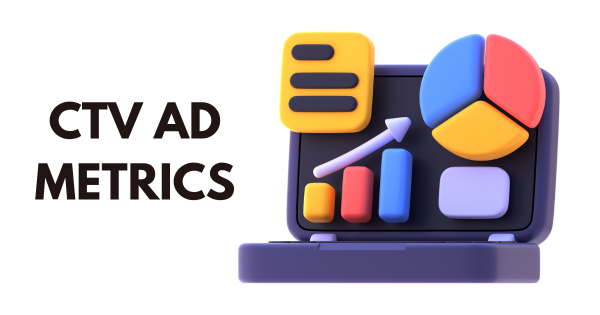Connected TV has opened up many interesting opportunities for advertisers, allowing them to reach audiences in more dynamic and innovative ways than ever before.
It has transformed how brands connect with consumers, making advertising more engaging and effective.
However, to leverage it to its fullest potential, you should know all the crucial strategies to run CTV ads.
Today, I will share 5 CTV Advertising Tips to help you get the most out of it!
Greater Engagement Through Interactivity
One of the most exciting opportunities CTV offers is the ability to create interactive ad experiences.
With CTV, advertisers can move beyond the static, one-way communication of traditional TV ads. They can incorporate interactive elements such as clickable overlays, shoppable ads, and QR codes that invite viewers to engage with the content directly.
This interactivity not only enhances the viewer experience but also increases the likelihood of conversion by allowing consumers to take immediate action, whether it’s visiting a website, downloading an app, or making a purchase.
How to Leverage it the Right Way?
These features are great I agree but incorporating it randomly just for the sake of using it won’t get you customers; instead it might make your brand look like spam.
Randomly incorporating interactive elements just for the sake of it can backfire, making your brand appear intrusive or spammy rather than engaging.
To truly benefit from these capabilities and encourage viewers to take action, it’s important to consider the following factors while running CTV ads:
Understand Your Audience’s Viewing Behavior
Before launching a CTV campaign, it’s crucial to have a deep understanding of your target audience.
Identify key demographics, interests, and viewing habits. Utilize data from previous campaigns, social media insights, and market research to create a detailed customer profile.
Know your audience’s viewing behavior by analyzing CTV ad metrics – What is their favorite platform? What are their favorite shows? What is their prime time? Who is their favorite character?
It will help you to analyze their taste & by aligning your interactive elements with your audience’s preferences, you can increase the likelihood of engagement.
For instance, if your target audience likes a character from a particular show & according to their search history their taste aligns with the character.
If you happen to have products that can be linked to the character, then you can leverage this information to display your products to them during that character’s scene & utilize these interactive elements to persuade them to take the desired action.
Integrate Interactivity Seamlessly
Interactive elements should feel like a natural extension of the ad, not a forced addition. For example, if you’re promoting a new product, a shoppable ad that allows viewers to purchase directly from the ad can be highly effective.
However, this should be done in a way that doesn’t disrupt the viewing experience. Ensure that the CTA is clear and intuitive, guiding viewers on what to do next without overwhelming them.
Time Your CTAs Appropriately
Timing is everything when it comes to interactive elements. Placing a CTA at the very start of an ad might catch viewers off guard while placing it too late might miss their attention.
A well-timed CTA, typically around the midpoint or just before the climax of the ad, can capture viewers’ attention when they are most engaged.
For example, if your ad tells a story, consider placing a QR code or clickable overlay right after the story’s most compelling moment.
Keep Interactions Simple and Clear
When it comes to interactivity, simplicity is key. Viewers are more likely to engage with interactive elements if they understand what is expected of them.
Avoid cluttered interfaces and confusing instructions.
For instance, if you’re using a QR code, make sure it’s easy to scan and that the landing page it leads to is mobile-friendly and directly related to the content of the ad.
Test and Optimize Your Interactive Elements
Not every interactive element will work perfectly on the first try. Testing different formats, placements, and timings can help you understand what resonates most with your audience.
Use A/B testing to compare different versions of your ads and analyze the data to determine which interactive elements drive the most engagement and conversions.
This iterative process of testing and optimizing will help you refine your strategy and improve the effectiveness of your interactive ads over time.
Leverage Data and Advanced Targeting
Another significant advantage of CTV advertising is its advanced measurement and attribution capabilities.
Unlike traditional TV, where it can be challenging to track the effectiveness of an ad campaign, CTV provides detailed insights into how ads are performing.
For instance, if your target audience consists of young adults interested in fitness, you can use data to target them specifically with ads that highlight your brand’s activewear line.
This level of precision helps maximize the efficiency of your ad spend by ensuring your ads are seen by those most likely to be interested in your products or services.
You can track a range of metrics, including ad impressions, viewability, completion rates, and even post-view actions.
Use first-party and third-party data to segment your audience based on behavior, location, device type, and other criteria.
Here are 16 important CTV Metrics that you should track to gauge your audience behavior around your brand/products.
Seamless Integration with Digital Campaigns
CTV advertising spans a variety of platforms and devices, from smart TVs and streaming devices to gaming consoles.
For instance, a user who views a CTV ad can later be retargeted with a similar ad on their mobile device or desktop.
This cohesive approach ensures that the messaging remains consistent across different touchpoints, reinforcing the brand’s presence and increasing the overall effectiveness of the campaign.
However, each platform has unique characteristics, and what works well on one might not work as effectively on another. Therefore, it’s important to optimize your ads for different screen sizes and formats to ensure they deliver the best possible viewing experience across all devices.
Consider the technical requirements and best practices for each platform when designing your ads. For instance, an ad that looks great on a large TV screen might need to be adjusted for a smaller streaming device.
Ensuring your ads are optimized for each platform will help maintain their visual appeal and effectiveness, regardless of how they are viewed.
Leverage Programmatic CTV Advertising
Programmatic CTV advertising is a powerful strategy that enables brands to maximize the efficiency and effectiveness of their advertising campaigns.
By using automated technology and data-driven algorithms, programmatic CTV allows advertisers to bid on ad inventory in real-time and target specific audiences with precision.
This approach not only streamlines the ad-buying process but also ensures that ads are served to the most relevant viewers, reducing waste and increasing ROI.
Additionally, programmatic CTV offers enhanced flexibility and scalability, allowing brands to adjust their campaigns quickly based on performance data and shifting market conditions.
By leveraging programmatic technology, advertisers can optimize their ad spend, reach highly engaged audiences, and achieve better outcomes in their CTV campaigns.
Learn More About Programmatic Advertising
Use the Right CTV Ad Format
Choosing the right ad format is crucial to the success of your Connected TV advertising campaigns.
Different formats serve different purposes and can impact viewer engagement differently.
Pre-roll ads, shown before the content starts, are ideal for capturing viewer attention early, while mid-roll ads, placed in the middle of the content, can engage viewers who are already immersed in the program.
Post-roll ads, which appear after the content, are suitable for reinforcing messages to an already captivated audience.
Interactive ads, such as shoppable ads or ads with clickable overlays, encourage direct engagement and immediate action from viewers.
Selecting the appropriate ad format based on your campaign goals and audience behavior can significantly enhance the effectiveness of your CTV advertising, ensuring your message resonates and drives desired actions.
Here are the Top 7 CTV Ad Formats & a brief overview of how each works. Dive in…
Conclusion
CTV advertising offers a wealth of opportunities for brands looking to engage with audiences in a more targeted and impactful way.
By understanding your audience, leveraging data and advanced targeting, creating high-quality content, optimizing for different platforms, and regularly measuring performance, you can maximize the impact of your CTV campaigns and achieve better results.
With these strategies in place, you’ll be well on your way to making the most of your CTV advertising efforts.




